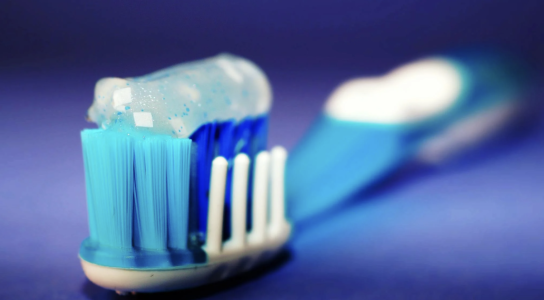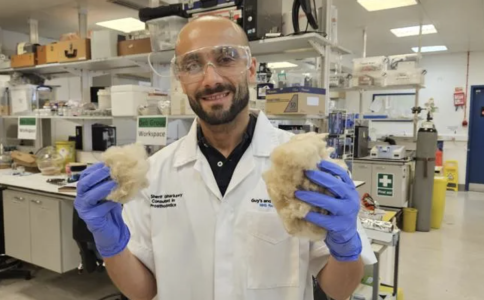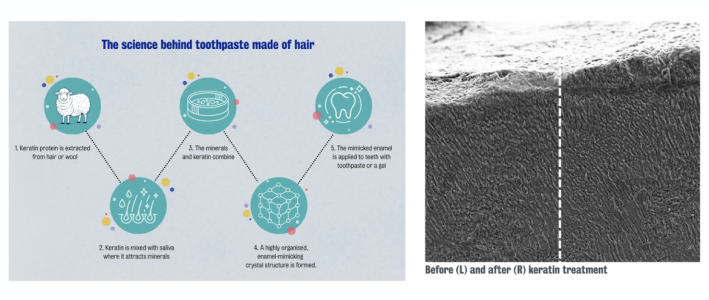A surprising new ingredient could change the future of dental care
By
Veronica E.
- Replies 0
Most of us don’t give much thought to toothpaste beyond picking our favorite flavor or brand.
But scientists have been working on something that could completely transform how we protect our teeth.
Imagine a product that not only fights cavities but can also rebuild enamel—something no standard toothpaste has ever been able to do.
The most unexpected part? The key ingredient comes from something you’d normally sweep off a salon floor or shear from a sheep’s back.
Researchers believe this surprising source could lead to healthier, stronger smiles in just a few years.

From hair to healthy teeth
Researchers at King’s College London have discovered that keratin—a tough, fibrous protein found in hair, skin, nails, and sheep’s wool—can be used to protect and repair tooth enamel.
When applied to teeth, keratin forms a dense mineral coating that mimics the structure and function of natural enamel.
This could help guard against decay and even repair early-stage damage, offering benefits fluoride alone cannot always provide.
Senior study author Dr. Sherif Elsharkawy explains, “We are entering an exciting era where biotechnology allows us to not just treat symptoms but restore biological function using the body’s own materials.”
Also read: This nail symptom might be a health red flag—are you ignoring the dangerous sign?
Turning keratin into dental protection
In their study, scientists extracted keratin from wool and applied it to tooth surfaces.
The protein interacts with minerals in saliva, creating a crystal-like “scaffolding” similar to real enamel.
This layer attracts calcium and phosphate ions, encouraging an enamel-like surface to grow over time—something natural enamel cannot do on its own since it lacks living cells.
The result could be a breakthrough for those dealing with sensitivity, thinning enamel, or cavities.
Also read: Get that finger-lickin’ fresh breath: Why everyone is obsessing over KFC’s new …toothpaste!?
Why this matters
Enamel erosion can result from acidic foods, aging, teeth grinding, dry mouth, or genetics—and once it’s gone, it’s gone.
Keratin-based treatments could offer an eco-friendly and effective alternative to synthetic resins, which are common in fillings but can be less durable and contain potentially harmful chemicals.
Lead author Sara Gamea notes that keratin is sustainably sourced from biological waste and avoids the need for traditional plastic resins.

Also read: Think you're brushing right? Here’s the surprising reason you should never rinse after brushing
What’s next for keratin in dentistry
Researchers believe keratin-based toothpaste or dental gels could reach consumers in as little as two years.
This innovation could mean fewer fillings, reduced sensitivity, and stronger teeth for patients.
It also offers an alternative for those who cannot use fluoride or prefer a different approach.
The development is part of a growing trend in regenerative dentistry—shifting from repairing damage to restoring natural function.

While research on keratin’s dental applications is still in its early stages, the findings offer a promising glimpse into new, natural ways to protect and restore teeth.
If future studies confirm its effectiveness, keratin-based treatments could become a valuable tool for reducing sensitivity and strengthening enamel.
Read next: The surprising link between your teeth and a healthy heart and brain—what dentists wish you knew

Would you be willing to try a toothpaste made from this surprising source, or would you stick to traditional options? Share your thoughts in the comments below!
But scientists have been working on something that could completely transform how we protect our teeth.
Imagine a product that not only fights cavities but can also rebuild enamel—something no standard toothpaste has ever been able to do.
The most unexpected part? The key ingredient comes from something you’d normally sweep off a salon floor or shear from a sheep’s back.
Researchers believe this surprising source could lead to healthier, stronger smiles in just a few years.

Innovative research could bring keratin-based toothpaste to shelves within just a few years, offering a new way to protect and restore teeth. Image Source: Pexels / George Becker.
From hair to healthy teeth
Researchers at King’s College London have discovered that keratin—a tough, fibrous protein found in hair, skin, nails, and sheep’s wool—can be used to protect and repair tooth enamel.
When applied to teeth, keratin forms a dense mineral coating that mimics the structure and function of natural enamel.
This could help guard against decay and even repair early-stage damage, offering benefits fluoride alone cannot always provide.
Senior study author Dr. Sherif Elsharkawy explains, “We are entering an exciting era where biotechnology allows us to not just treat symptoms but restore biological function using the body’s own materials.”
Also read: This nail symptom might be a health red flag—are you ignoring the dangerous sign?
Turning keratin into dental protection
In their study, scientists extracted keratin from wool and applied it to tooth surfaces.
The protein interacts with minerals in saliva, creating a crystal-like “scaffolding” similar to real enamel.
This layer attracts calcium and phosphate ions, encouraging an enamel-like surface to grow over time—something natural enamel cannot do on its own since it lacks living cells.
The result could be a breakthrough for those dealing with sensitivity, thinning enamel, or cavities.
Also read: Get that finger-lickin’ fresh breath: Why everyone is obsessing over KFC’s new …toothpaste!?
Why this matters
Enamel erosion can result from acidic foods, aging, teeth grinding, dry mouth, or genetics—and once it’s gone, it’s gone.
Keratin-based treatments could offer an eco-friendly and effective alternative to synthetic resins, which are common in fillings but can be less durable and contain potentially harmful chemicals.
Lead author Sara Gamea notes that keratin is sustainably sourced from biological waste and avoids the need for traditional plastic resins.

Keratin (seen here) is being explored for its potential to mimic natural enamel, offering protection for teeth and possibly sealing exposed nerve channels that contribute to sensitivity. Image Source: King’s College London.
Also read: Think you're brushing right? Here’s the surprising reason you should never rinse after brushing
What’s next for keratin in dentistry
Researchers believe keratin-based toothpaste or dental gels could reach consumers in as little as two years.
This innovation could mean fewer fillings, reduced sensitivity, and stronger teeth for patients.
It also offers an alternative for those who cannot use fluoride or prefer a different approach.
The development is part of a growing trend in regenerative dentistry—shifting from repairing damage to restoring natural function.

Keratin-based dental technology may help recreate enamel-like structures, offering a natural way to protect teeth and reduce sensitivity. Image Source: King’s College London.
While research on keratin’s dental applications is still in its early stages, the findings offer a promising glimpse into new, natural ways to protect and restore teeth.
If future studies confirm its effectiveness, keratin-based treatments could become a valuable tool for reducing sensitivity and strengthening enamel.
Read next: The surprising link between your teeth and a healthy heart and brain—what dentists wish you knew
Key Takeaways
- Scientists at King’s College London found keratin—a protein in hair, skin, nails, and wool—can help protect and repair tooth enamel.
- Keratin interacts with saliva to form a mineral “scaffolding” that mimics enamel and encourages regrowth over time.
- This approach offers an eco-friendly alternative to synthetic dental resins, using sustainably sourced biological waste.
- Keratin-based toothpaste or gels could be available within two years, offering a new tool for fighting sensitivity and enamel erosion.
Would you be willing to try a toothpaste made from this surprising source, or would you stick to traditional options? Share your thoughts in the comments below!






